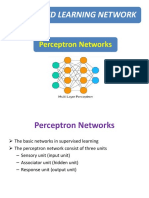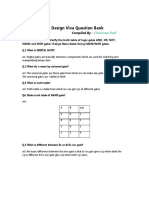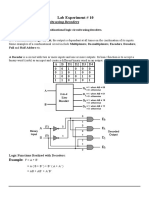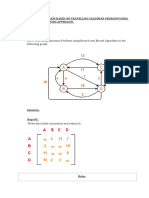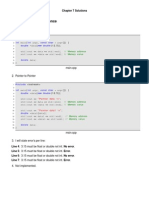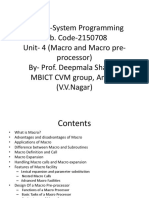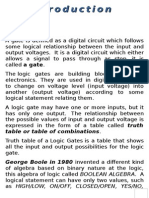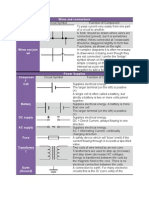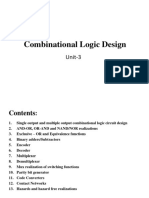Basic Electronics and Electrical
Engineering: ECE 249
UNIT V: Introduction to
Combinational Logic Circuits
Lecture No.: 20
Topic: Introduction to
Combinational Logic Circuits
Delivered By: Dr. Irfan Ahmad Pindoo
Head, Patent and Design Cell
Division of Research and Development
Intellectual Property Rights Cell
Introduction to Combinational Circuits
• Combinational logic is a type of digital logic which is implemented by Boolean
circuits, where the output is a pure function of the present inputs only.
• The combinational circuit do not use any memory.
• The previous state of input does not have any effect on
the present state of the circuit.
Prepared and Delivered By: Irfan Ahmad Pindoo 2
Design Procedure
Prepared and Delivered By: Irfan Ahmad Pindoo 3
Design Procedure:
BCD to Excess-3 Code Conversion
How many
Design of
inputs and
Truth Table
outputs
Simplification Design the
with K-map circuit
Prepared and Delivered By: Irfan Ahmad Pindoo 4
Design Procedure:
BCD to Excess-3 Code Conversion
STEP: 1 and 2
Prepared and Delivered By: Irfan Ahmad Pindoo 5
Design Procedure:
BCD to Excess-3 Code Conversion
Prepared and Delivered By: Irfan Ahmad Pindoo 6
Design Procedure:
BCD to Excess-3 Code Conversion
STEP: 3
Prepared and Delivered By: Irfan Ahmad Pindoo 7
Design Procedure:
BCD to Excess-3 Code Conversion
STEP: 3
Prepared and Delivered By: Irfan Ahmad Pindoo 8
Design Procedure:
BCD to Excess-3 Code Conversion
STEP: 4
Prepared and Delivered By: Irfan Ahmad Pindoo 9
Basic Electronics and Electrical
Engineering: ECE 249
UNIT V: Introduction to
Combinational Logic Circuits
Lecture No.: 21
Topic: Adder Circuits
Delivered By: Dr. Irfan Ahmad Pindoo
Head, Patent and Design Cell
Division of Research and Development
Intellectual Property Rights Cell
Half Adder
A combinational logic circuit with two inputs and two
outputs.
The half adder circuit add two single bits without any
carry.This circuit has two outputs carry and sum.
Prepared and Delivered By: Irfan Ahmad Pindoo 11
Half Adder
Prepared and Delivered By: Irfan Ahmad Pindoo 12
QUICK QUIZ (POLL)
If A and B are the inputs of a half adder, the sum is given by __________
a) A AND B
b) A OR B
c) A XOR B
d) A EX-NOR B
Prepared and Delivered By: Irfan Ahmad Pindoo 13
QUICK QUIZ (POLL)
Total number of inputs in a half adder is __________
a) 2
b) 3
c) 4
d) 1
Prepared and Delivered By: Irfan Ahmad Pindoo 14
Full Adder
A combinational logic circuit with 3 inputs and 2 outputs.
The Full adder circuit adds 3 bits including carry.
ABC ABC ABC ABC
A( BC BC ) A( BC BC )
A( B C ) A( BC )
Let B C D
AD AD
A D
A B C
Prepared and Delivered By: Irfan Ahmad Pindoo 15
Full Adder
Prepared and Delivered By: Irfan Ahmad Pindoo 16
Full Adder
Prepared and Delivered By: Irfan Ahmad Pindoo 17
QUICK QUIZ (POLL)
If A, B and C are the inputs of a full adder then the carry is given by
__________
a) A AND B OR (A OR B) AND C
b) A OR B OR (A AND B) C
c) (A AND B) OR (A AND B)C
d) A XOR B XOR (A XOR B) AND C
Prepared and Delivered By: Irfan Ahmad Pindoo 18
Implementation of Full Adder using Half Adders
Prepared and Delivered By: Irfan Ahmad Pindoo 19
Implementation of Ripple Carry Adder (RCA):4-bits
Prepared and Delivered By: Irfan Ahmad Pindoo 20
Basic Electronics and Electrical
Engineering: ECE 249
UNIT V: Introduction to
Combinational Logic Circuits
Lecture No.: 22
Topic: Subtractor Circuits
Delivered By: Dr. Irfan Ahmad Pindoo
Head, Patent and Design Cell
Division of Research and Development
Intellectual Property Rights Cell
Half Subtractor
Combinational circuit perform binary subtraction
accepts 2 inputs and provides two outputs: Difference
and Borrow
Prepared and Delivered By: Irfan Ahmad Pindoo 22
Full Subtractor
Performs subtraction of 3 bits
This circuit has three inputs and two outputs.
The three inputs A, B and C, denote the minuend, subtrahend, and
previous borrow, respectively.
The two outputs are: D and Bout
Sum(A, B,C) = ∑m (1, 2, 4, 7)
Bout(A, B,C) = ∑m (1,2,3,7)
Prepared and Delivered By: Irfan Ahmad Pindoo 23
Full Subtractor
Bout = A’B’C + A’BC’ + A’BC + ABC
= C(AB + A’B’) + A’B(C + C’)
= C( A XNOR B) + A’B
= C (A XOR B)’ + A’B
Prepared and Delivered By: Irfan Ahmad Pindoo 24
Implementation of Full Subtractor using Half
Subtractor
Prepared and Delivered By: Irfan Ahmad Pindoo 25
QUICK QUIZ (POLL)
The difference between half adder and full adder is __________
a) Half adder has two inputs while full adder has four inputs
b) Half adder has one output while full adder has two outputs
c) Half adder has two inputs while full adder has three inputs
d) All of the Mentioned
Prepared and Delivered By: Irfan Ahmad Pindoo 26
QUICK QUIZ (POLL)
How many AND, OR and EXOR gates are required for the configuration of full
adder?
a) 1, 2, 2
b) 2, 1, 2
c) 3, 1, 2
d) 4, 0, 1
Prepared and Delivered By: Irfan Ahmad Pindoo 27
Try Yourself
Design a 3 input digital circuit which produces high output for ODD decimal equivalent?
Prepared and Delivered By: Irfan Ahmad Pindoo 28
Decoder
What is a Decoder?
A combinational circuit that has ‘n’ input lines and maximum of 2𝑛 output lines.
One of these outputs will be active High based on the combination of inputs present, when
the decoder is enabled.
The outputs of the decoder are min terms of ‘n’ input variables lines when it is enabled
Prepared and Delivered By: Irfan Ahmad Pindoo 29
2x4 Decoder
Prepared and Delivered By: Irfan Ahmad Pindoo 30
2x4 Decoder
Delivered By: Irfan Ahmad Pindoo 31
2x4 Decoder
Therefore, the outputs of 2 to 4 decoder are nothing but
the min terms of two input variables A1 & A0, when enable,
E is equal to one. If enable, E is zero, then all the outputs of
decoder will be equal to zero.
Delivered By: Irfan Ahmad Pindoo 32
3x8 Decoder
Delivered By: Irfan Ahmad Pindoo 33
3x8 Decoder: Active High
Delivered By: Irfan Ahmad Pindoo 34
3x8 Decoder: Active Low
Delivered By: Irfan Ahmad Pindoo 35
Basic Electronics and Electrical
Engineering: ECE 249
UNIT V: Introduction to
Combinational Logic Circuits
Lecture No.: 23
Topic: Decoders and
Implementation of Boolean
Functions using Decoders
Delivered By: Dr. Irfan Ahmad Pindoo
Head, Patent and Design Cell
Division of Research and Development
Intellectual Property Rights Cell
Full Adder Design using 3:8 Decoder
Delivered By: Irfan Ahmad Pindoo 37
Full Subtractor Design using 3:8 Decoder
Delivered By: Irfan Ahmad Pindoo 38
3:8 Decoder using 2:4 Decoder
A2 A1 A0 HIGH OUTPUT
0 0 0 Y0
0 0 1 Y1
0 1 0 Y2
0 1 1 Y3
1 0 0 Y4
1 0 1 Y5
1 1 0 Y6
1 1 1 Y7
Delivered By: Irfan Ahmad Pindoo 39
4:16 Decoder
A3 Y0
A2
A1
4:16
Y15
Decoder
A0
EN
4:16 Decoder using 3:8 Decoder
4:16 Decoder using 2:4 Decoder
Basic Electronics and Electrical
Engineering: ECE 249
UNIT V: Introduction to
Combinational Logic Circuits
Lecture No.: 24
Topic: Multiplexers and
Implementation of Boolean
Functions using Multiplexers
Delivered By: Dr. Irfan Ahmad Pindoo
Head, Patent and Design Cell
Division of Research and Development
Intellectual Property Rights Cell
Multiplexer
The multiplexer, shortened to “MUX” or is a combinational logic circuit designed to switch one
of several input lines through to a single common output line by the application of a control
signal.
Multiplexers operate like very fast acting multiple position rotary switches connecting or
controlling multiple input lines called “channels” one at a time to the output.
Prepared and Delivered By: Irfan Ahmad Pindoo 44
Multiplexer
o Multiplexer is a combinational circuit that has maximum of 2n data inputs, ‘n’ selection lines
and single output line. One of these data inputs will be connected to the output based on the
values of selection lines.
o Since there are ‘n’ selection lines, there will be 2n possible combinations of zeros and ones. So,
each combination will select only one data input. Multiplexer is also called as Mux.
Prepared and Delivered By: Irfan Ahmad Pindoo 45
QUICK QUIZ (POLL)
Which combinational circuit is renowned for selecting a single input from multiple inputs &
directing the binary information to output line?
a) Data Selector
b) Data distributor
c) Both data selector and data distributor
d) DeMultiplexer
Prepared and Delivered By: Irfan Ahmad Pindoo 46
2:1 Multiplexer
Prepared and Delivered By: Irfan Ahmad Pindoo 47
QUICK QUIZ (POLL)
What is the function of an enable input on a multiplexer chip?
a) To apply Vcc
b) To connect ground
c) To active the entire chip
d) To active one half of the chip
Prepared and Delivered By: Irfan Ahmad Pindoo 48
4:1 Multiplexer
Selection Lines Output
S1 S0 Y
0 0 I0
0 1 I1
1 0 I2
1 1 I3
Prepared and Delivered By: Irfan Ahmad Pindoo 49
Boolean Function Implementation using Multiplexer
Implement f = 𝟏, 𝟑, 𝟓, 𝟔 using 4:1 MUX?
Prepared and Delivered By: Irfan Ahmad Pindoo 50
Boolean Function Implementation using Multiplexer
TRY YOURSELF
Implement f = 𝟎, 𝟐, 𝟒, 𝟓, 𝟔 using 4:1 MUX?
Prepared and Delivered By: Irfan Ahmad Pindoo 51
Full Adder Implementation using Multiplexer
TRY YOURSELF
Prepared and Delivered By: Irfan Ahmad Pindoo 52
Logic Gates Implementation using Multiplexer
AND GATE OR GATE
NOR GATE
NAND GATE
Prepared and Delivered By: Irfan Ahmad Pindoo 53
Logic Gates Implementation using Multiplexer
XNOR GATE
XOR GATE
NOT GATE
Prepared and Delivered By: Irfan Ahmad Pindoo 54
Multiplexer Trees
Multilplexers with higher number of inputs can be implemented by cascading
two or more multiplexers with less number of inputs.
Prepared and Delivered By: Irfan Ahmad Pindoo 55
4:1 MUX using 2:1 MUX
Prepared and Delivered By: Irfan Ahmad Pindoo 56
8:1 MUX using 4:1 MUX
Prepared and Delivered By: Irfan Ahmad Pindoo 57
8:1 MUX: Example
Question: Implement the Boolean function 𝒇(𝑨, 𝑩, 𝑪, 𝑫) = 𝟏, 𝟑, 𝟒, 𝟏𝟏, 𝟏𝟐, 𝟏𝟑, 𝟏𝟒, 𝟏𝟓 using Multiplexer?
Prepared and Delivered By: Irfan Ahmad Pindoo 58
8:1 MUX: Example
Question: Implement the Boolean function 𝒇(𝑨, 𝑩, 𝑪, 𝑫) = 𝟏, 𝟑, 𝟒, 𝟏𝟏, 𝟏𝟐, 𝟏𝟑, 𝟏𝟒, 𝟏𝟓 using Multiplexer?
Prepared and Delivered By: Irfan Ahmad Pindoo 59
Basic Electronics and Electrical
Engineering: ECE 249
UNIT V: Introduction to
Combinational Logic Circuits
Lecture No.: 25
Topic: Demultiplexers and
Encoder, Limitation of
conventional Encoder
Delivered By: Dr. Irfan Ahmad Pindoo
Head, Patent and Design Cell
Division of Research and Development
Intellectual Property Rights Cell
De-Multiplexer
De-Multiplexer is a combinational circuit that performs the reverse operation of Multiplexer.
It has single input, ‘n’ selection lines and maximum of 2𝑛 outputs.
The input will be connected to one of these outputs based on the values of selection lines.
Prepared and Delivered By: Irfan Ahmad Pindoo 61
De-Multiplexer
o The demultiplexer converts a serial data signal at the input to a parallel data at its output lines
as shown below.
Prepared and Delivered By: Irfan Ahmad Pindoo 62
1:4 De-Multiplexer
Prepared and Delivered By: Irfan Ahmad Pindoo 63
1:4 De-Multiplexer
Prepared and Delivered By: Irfan Ahmad Pindoo 64
1:8 De-MUX using 1:4 De-MUX
Prepared and Delivered By: Irfan Ahmad Pindoo 65
QUICK QUIZ (POLL)
To implement 1:8 de-mux how many 1:2 de-mux would be required?
a) 2
b) 4
c) 5
d) 6
Prepared and Delivered By: Irfan Ahmad Pindoo 66
Encoder
An encoder is a combinational circuit that performs the inverse operation of a decoder.
An encoder has 2𝑛 (or fewer) input lines and n output lines.
The output lines, as an aggregate, generate the binary code corresponding to the input value.
Prepared and Delivered By: Irfan Ahmad Pindoo 67
Encoder: Example
Qsn: Design an octal to binary encoder?
Prepared and Delivered By: Irfan Ahmad Pindoo 68
Encoder: Example
Qsn: Design an octal to binary encoder?
Prepared and Delivered By: Irfan Ahmad Pindoo 69
Encoder: Example
Qsn: Design an octal to binary encoder?
Prepared and Delivered By: Irfan Ahmad Pindoo 70
QUICK QUIZ (POLL)
How is an encoder different from a decoder?
a) The output of an encoder is a binary code for 1-of-N input
b) The output of a decoder is a binary code for 1-of-N input
c) The output of an encoder is a binary code for N-of-1 output
d) The output of a decoder is a binary code for N-of-1 output
Prepared and Delivered By: Irfan Ahmad Pindoo 71
QUICK QUIZ (POLL)
How many outputs will a decimal-to-BCD encoder have?
a) 4
b) 8
c) 12
d) 16
Prepared and Delivered By: Irfan Ahmad Pindoo 72
Limitations of Encoder
There is an ambiguity, when all outputs of encoder are equal to zero. Because, it could be the
code corresponding to the inputs, when only least significant input is one or when all inputs
are zero.
If more than one input is active High, then the encoder produces an output, which may not be
the correct code. For example, if both Y3 and Y6 are ‘1’, then the encoder produces 111 at the
output. This is neither equivalent code corresponding to Y3, when it is ‘1’ nor the equivalent
code corresponding to Y6, when it is ‘1’.
So, to overcome these difficulties, we should assign priorities to each input of encoder. Then,
the output of encoder will be the binary code corresponding to the active High inputs, which
has higher priority. This encoder is called as priority encoder.
Prepared and Delivered By: Irfan Ahmad Pindoo 73
Basic Electronics and Electrical
Engineering: ECE 249
UNIT V: Introduction to
Combinational Logic Circuits
Lecture No.: 26
Topic: Priority Encoder and
Magnitude Comparator (1-bit and
2-bits), Parity Circuit
Delivered By: Dr. Irfan Ahmad Pindoo
Head, Patent and Design Cell
Division of Research and Development
Intellectual Property Rights Cell
Priority Encoder
A priority encoder is an encoder circuit that includes the priority function. The operation of
the priority encoder is such that if two or more inputs are equal to 1 at the same time, the
input having the highest priority will take precedence.
In addition to the two outputs x and y, the circuit has a third output designated by V; this is a
valid bit indicator that is set to 1 when one or more inputs are equal to 1. If all inputs are 0,
there is no valid input and V is equal to 0.
The other two outputs are not inspected when V equals 0 and are specified as don’t-care
conditions.
Prepared and Delivered By: Irfan Ahmad Pindoo 75
Priority Encoder
Designing of 4X2 Priority Encoder
Prepared and Delivered By: Irfan Ahmad Pindoo 76
Priority Encoder
Designing of 4X2 Priority Encoder
Prepared and Delivered By: Irfan Ahmad Pindoo 77
Priority Encoder
Designing of 4X2 Priority Encoder
Prepared and Delivered By: Irfan Ahmad Pindoo 78
Magnitude Comparator
Another common and very useful combinational logic circuit is that of the Digital Comparator
circuit.
Digital or Binary Comparators are made up from standard AND, NOR and NOT gates that
compare the digital signals present at their input terminals and produce an output depending
upon the condition of those inputs.
Prepared and Delivered By: Irfan Ahmad Pindoo 79
1-Bit Magnitude Comparator
Another common and very useful combinational logic circuit is that of the Digital Comparator
circuit.
Digital or Binary Comparators are made up from standard AND, NOR and NOT gates that
compare the digital signals present at their input terminals and produce an output depending
upon the condition of those inputs.
Prepared and Delivered By: Irfan Ahmad Pindoo 80
2-Bit Magnitude Comparator
Step 1: Step 2 and 3:
Determine number of inputs and
outputs.
Prepared and Delivered By: Irfan Ahmad Pindoo 81
2-Bit Magnitude Comparator
Step 2 and 3: Step 4: K Maps
Prepared and Delivered By: Irfan Ahmad Pindoo 82
2-Bit Magnitude Comparator
Step 2 and 3: Step 4: K Maps
Prepared and Delivered By: Irfan Ahmad Pindoo 83
2-Bit Magnitude Comparator
Step 5: Logic Circuit
Prepared and Delivered By: Irfan Ahmad Pindoo 84
Parity Generation and Checking
Exclusive-OR functions are very useful in systems requiring error detection and correction
codes.
A parity bit is an extra bit included with a binary message to make the number of 1’s either
odd or even.
The message, including the parity bit, is transmitted and then checked at the receiving end
for errors.
The circuit that generates the parity bit in the transmitter is called a parity generator. The
circuit that checks the parity in the receiver is called a parity checker.
Prepared and Delivered By: Irfan Ahmad Pindoo 85
Parity Generation and Checking
Prepared and Delivered By: Irfan Ahmad Pindoo 86
Parity Generation and Checking
Prepared and Delivered By: Irfan Ahmad Pindoo 87











